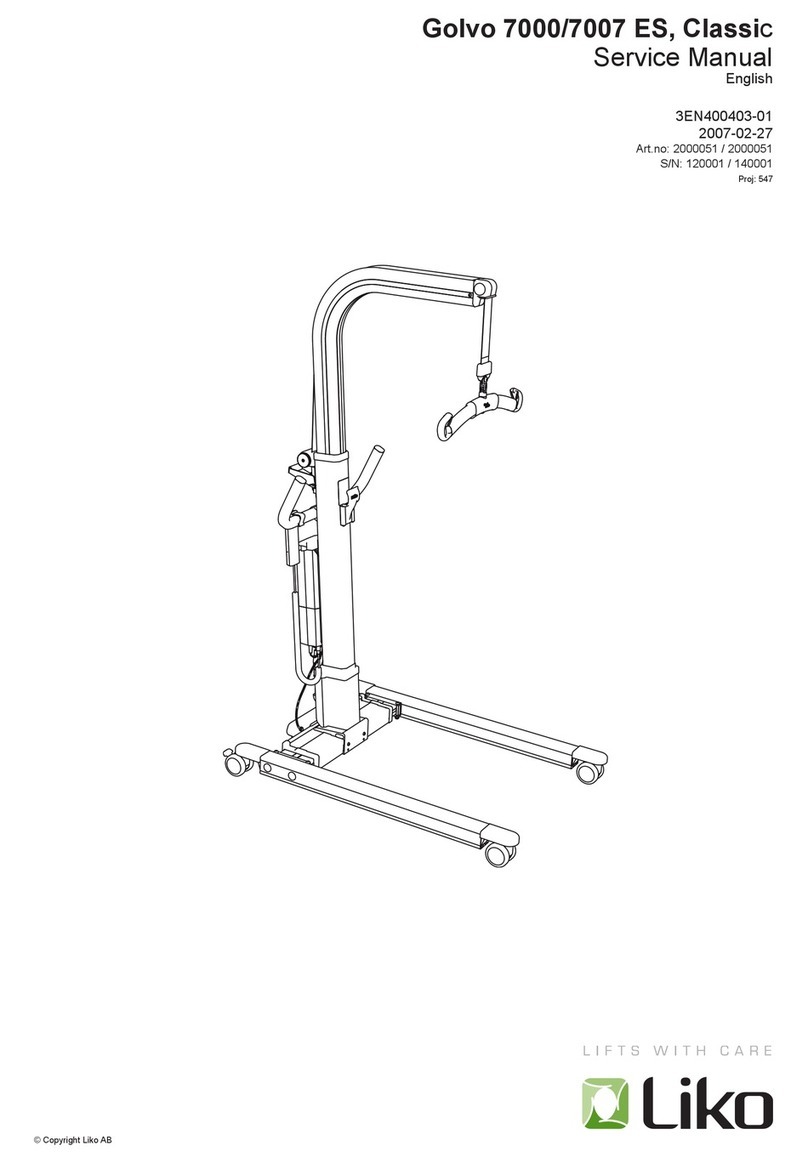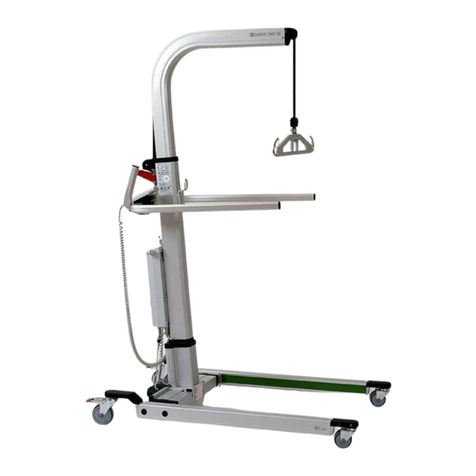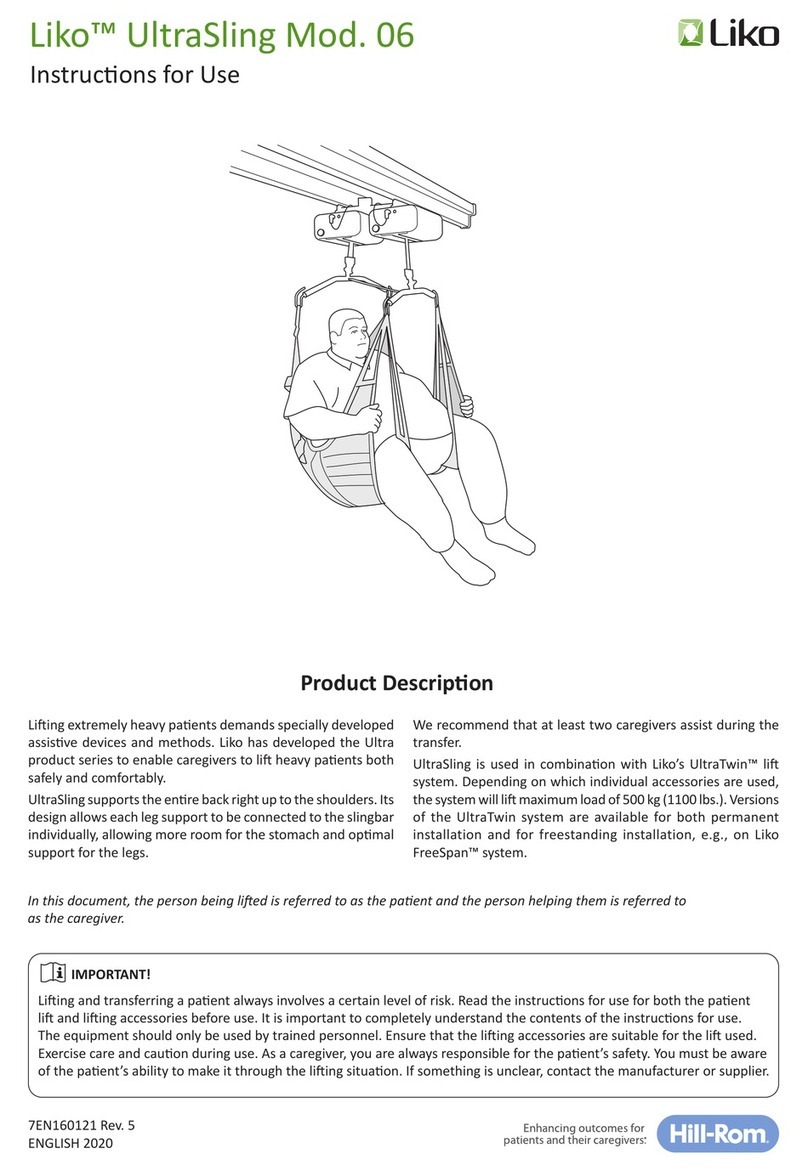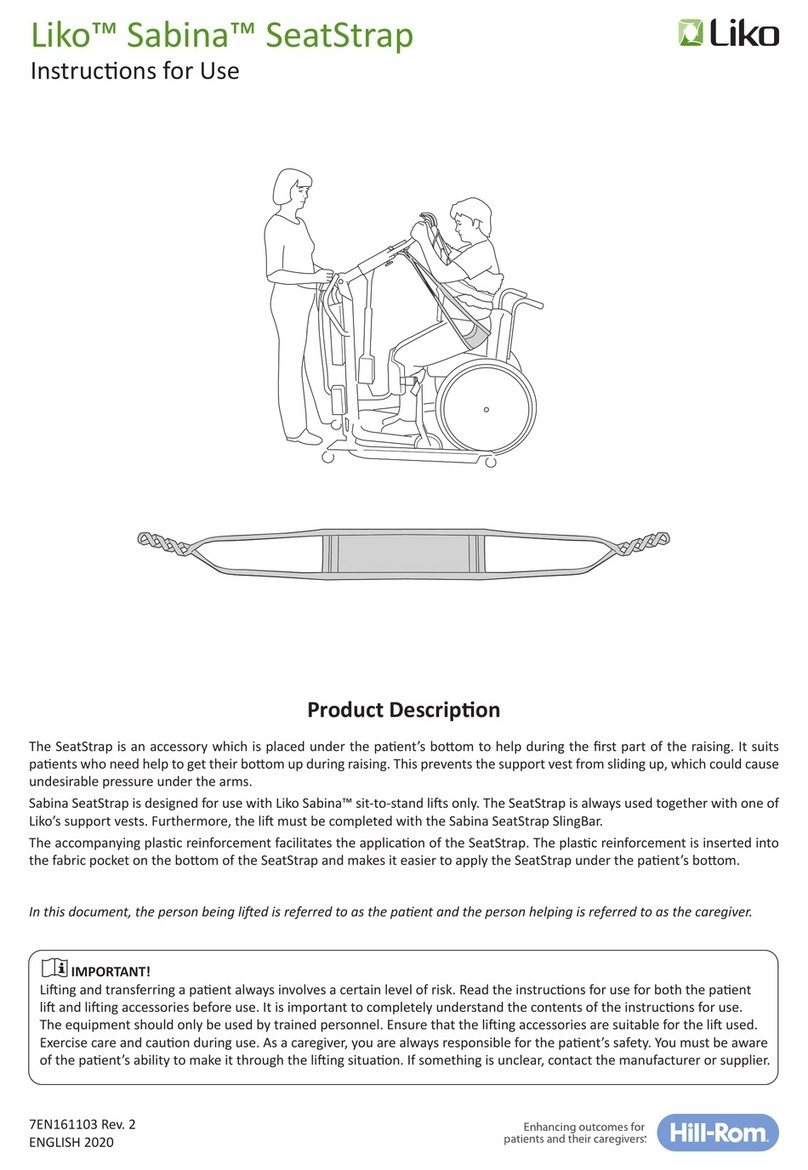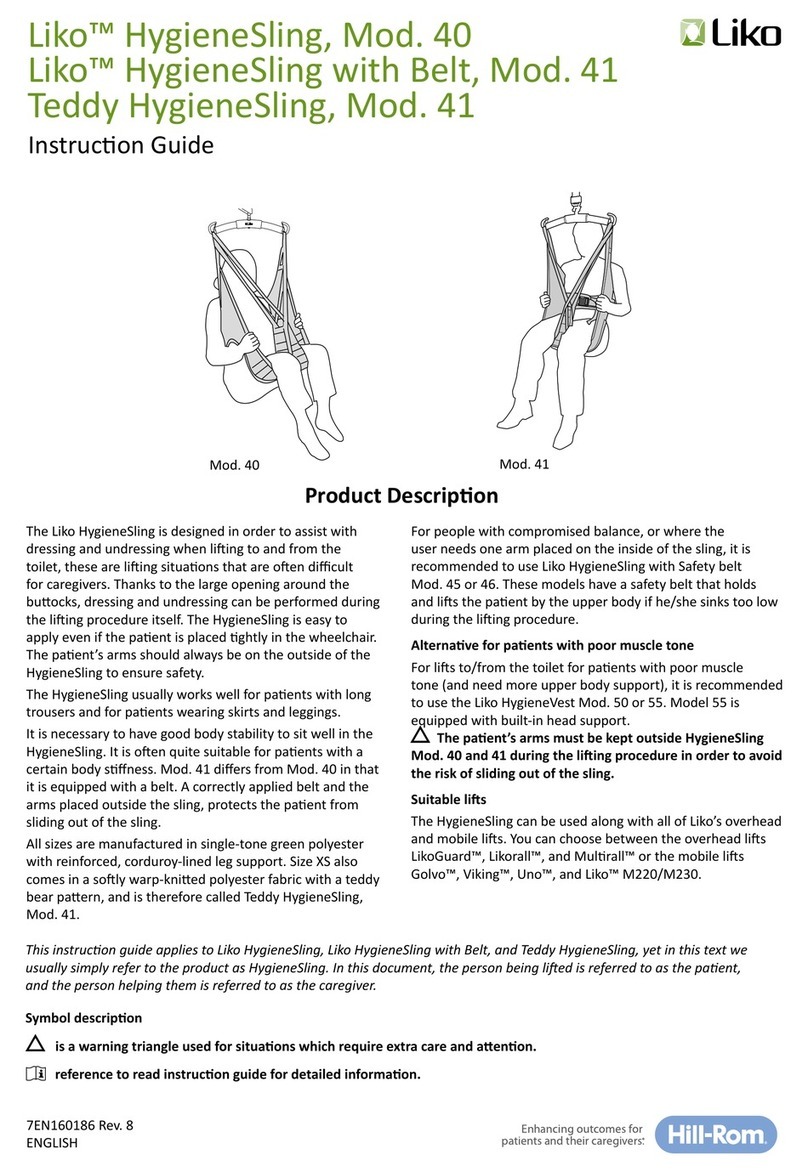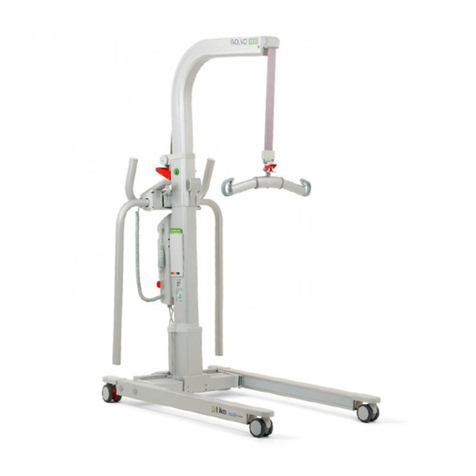Liko OriginalSling 11 Manual

Liko OriginalSling is a basic model which is designed to
adapt to the paent without individual adjustments.
A properly ed and carefully applied sling will give the
paent an excellent sense of security, as well as a high
degree of comfort.
On the adult sizes MS-XL, paents can hold their arms
either outside or inside the sling. The choice oen depends
on the capacity of the paent and their ability to parcipate
in the liing operaon. The choice of sling bar also aects
how the arms are placed. Child sizes XS-S are designed so
that the child’s arms are always placed inside the sling.
Sizes
The OriginalSling is available in dierent sizes. It is
important to choose the correct size in order to achieve
the highest level of comfort and safety. A sling which is too
large increases the risk of the paent sliding out of it, while
one which is too small can cut into the groin and cause
discomfort.
For larger sizes, a combinaon with Liko Universal TwinBar
670 can be a good choice.
Fabrics
The OriginalSling is available in dierent fabrics. Since the
OriginalSling is not usually le under the paent aer the
transfer, we recommend the polyester design. TeddySling
Original is made in a teddy bear paerned warp-knied
polyester. These fabrics are durable and has low fricon,
making the sling easy to apply and easy to remove.
The OriginalSling is also available in net polyester. This
fabric is recommended when the sling is le in place aer
the transfer or when an airier alternave is desired.
For bathing and showering, a plasc-coated polyester net
design is available, which is water permeable and can easily
be wiped. This material dries quickly and does not chill the
paent in the same way as a damp, absorbent fabric would.
The sling’s li straps are always made of durable polyester
and are very secure.
Leg Supports
The OriginalSling is available with leg supports in dierent
designs. Most common are reinforced leg supports. The
reinforcement provides high comfort, distribute the
pressure and prevent the sling from creasing under the
thighs.
One design has simple fabric without reinforcement in the
leg supports, making the sling more pliable and easy to care
for.
Another type has reinforcement in both the leg supports
and the back, which provides extra back support and can
facilitate the applicaon of the sling.
Finally there is also one design with so-padded leg
supports (synthec sheepskin). This is suitable for especially
pressure-sensive paents.
is a warning triangle used for situaons which require extra care and aenon.
This instrucon guide applies to the Liko OriginalSling and the TeddySling Original, yet in this text we refer only to the
OriginalSling. In this document, the person being lied is referred to as the paent, and the person helping is referred to
as the caregiver.
Product Descripon
OriginalSling TeddySling Original
Liko™ OriginalSling Mod. 10, 11
TeddySling Original Mod. 10
Instrucon Guide
7EN160165 Rev. 10
ENGLISH

2www.hill-rom.com I www.liko.com
Liko™ OriginalSling • 7EN160165 Rev. 10
Table of Contents
Safety Instrucons ................................................................................................................................... 3-4
Care and Maintenance ............................................................................................................................... 4
Denions .................................................................................................................................................. 4
How to Aach a Sling to Dierent Sling Bars .............................................................................................. 5
How to Aach an Original Sling to a Sling Bar with 4 Hooks (Twin Bars and Cross Bars) ........................... 6
Liing from a Sing Posion ................................................................................................................... 7-8
Liing to a Sing Posion .......................................................................................................................... 8
Removing the Sling in a Chair/Wheelchair .................................................................................................. 8
Liing from the Bed ..................................................................................................................................... 9
Liing from the Floor................................................................................................................................... 9
Liing to the bed ....................................................................................................................................... 10
Removing the Sling when the Paent is Sing in Bed .............................................................................. 10
Removing the Sling when the Paent is Lying in Bed ................................................................................ 10
Fing Advice ............................................................................................................................................. 11
Dierent Ways of Connecng Leg Supports .............................................................................................. 11
The Paent does not Sit Well in the Sling – Why is This? .......................................................................... 11
Shortening Posion ................................................................................................................................... 11
Overview, Liko Original Sling, Mod. 10, 11 ................................................................................................ 12
Symbol Descripon ................................................................................................................................... 12
Recommended Combinaons ................................................................................................................... 12

23
Liko™ OriginalSling • 7EN160165 Rev. 10 www.hill-rom.com I www.liko.com
Before liing, keep the following points in mind:
• A responsible person within your organizaon should decide on a case-by-case basis whether one or more caregivers are
needed.
• Ensure that the sling selected meets the paent’s needs with reference to model, size, fabric and design.
• For safety and hygiene reasons, use individual slings.
• Before liing, plan the liing operaon so that it can be done as safely and smoothly as possible.
• Before liing, check that the liing accessory hangs vercally and can move freely.
• Although Liko’s sling bars are equipped with latches, special cauon must be exercised: before the paent is lied from the
underlying surface, but aer the straps have been fully extended, make sure the straps are properly connected to the sling bar.
• Make sure the paent is sing securely in the sling before transferring to another locaon.
• Never li a paent higher o the underlying surface than is needed to complete the liing and transfer procedure.
• Never leave a paent unaended during a liing situaon.
• Make sure that the wheels on the wheelchair, bed, gurney, etc., are locked during the liing/transfer operaon.
• Always work ergonomically. Use the paent’s ability to acvely parcipate in the operaons.
• When the sling is not being used, do not place in direct sun light.
Safety Instrucons
Liko’s products undergo connuous development, which is why we reserve the right to make product changes without prior
noce. Contact your Hill-Rom representave for advice and informaon about product upgrades.
Medical Device Class I
Liko OriginalSling complies with the harmonized standard ISO10535:2006.
IMPORTANT!
Liing and transferring a paent always involves a certain risk. Read the instrucon guide for both the li and liing
accessories before use. It is important to completely understand the contents of the instrucon guide. The equipment should
be used only by trained personnel. Ensure that the liing accessories are suitable for the li being used. Exercise care and
cauon during use. As a caregiver, you are always responsible for the paent’s safety. You must be aware of the paent’s
ability to handle the liing situaon.
The management system for both manufacturing and development of the product is cered in accordance with ISO9001
and its equivalent for the medical device industry, ISO13485. The management system is also cered in accordance with the
environmental standard ISO14001.
PATENT www.hill-rom.com/patents
May be covered by one or more patents. See above Internet address.
The Hill-Rom companies are the proprietors of European, US, and other patents and pending patent applicaons.
Design and Quality by Liko in Sweden

4www.hill-rom.com I www.liko.com
Liko™ OriginalSling • 7EN160165 Rev. 10
Denions
1. Product label
2. Label: Manufacturing year and month , Serial number SN
3. Label: Individual marking (Belongs to)
4. Label: Periodic Inspecon
5. Upper strap loop
6. Handle
7. Belt (where applicable)
8. Center back strap / Size marking
9. Lower edge
10. Leg support
11. Shortening posion
12. Leg support loop
5
43
2
1
7
6
8
9
10
11
12
Care and Maintenance
Check the sling before each use. Check the following points with regard to wear and damage:
• Fabric
• Straps
• Seams
• Suspension loops
Do not use damaged liing accessories.
If anything is unclear, please contact the manufacturer or supplier.
Washing instrucons: Please see the sling’s product label and the aached appendix ”Care and Maintenance of Liko Slings”.
Expected Life Time
The product has an expected life me of 1-5 years with normal use. Expected life me varies depending on the fabric, use
frequency, washing procedure, and weight carried.
Periodic Inspecon
The product must be inspected at least once every 6 months. More frequent inspecons might be required if the product is
used or washed more oen than normal. See Liko’s protocol ”Periodic Inspecon Liko Texle Products”.

45
Liko™ OriginalSling • 7EN160165 Rev. 10 www.hill-rom.com I www.liko.com
Sling bar Sling loops to sling bar hooks Correct
SlingGuard™
Universal
SlingGuard™ Twin
Universal Twin
Cross-bar
Wrong!
How to Aach a Sling to Dierent Sling Bars

6www.hill-rom.com I www.liko.com
Liko™ OriginalSling • 7EN160165 Rev. 10
How to Aach an OriginalSling to a Sling Bar with 4 Hooks
(Twin Bars and Cross Bars)
The illustraons 1, 2, and 3 shows a twin bar but this
also applies to a Cross-bar.
1.
2. 3.
A
B
Upper strap loop
Leg support loop
BB
A
A
B
ABA

67
Liko™ OriginalSling • 7EN160165 Rev. 10 www.hill-rom.com I www.liko.com
Place the sling behind the paent’s back with the product
label outwards. Fold up the lower edge of the sling around
your nger ps to facilitate guiding the sling into place.
Liing from a Sing Posion
Using the palm of your hand, push the lower edge of the
sling down to the level of the paent’s coccyx -this is very
important. Tip: Correct posioning is facilitated if the
paent leans/is leaned forward slightly.
Pull the sling’s leg supports forward along the outside of the
paent’s thighs. Place the palm of your hand between the
paent’s body and the sling and push the leg support’s lower
edge down towards the seat. Simultaneously, pull the leg
support forward with the other hand to stretch it.
Pull the leg supports forward to smooth out any creases in
the back. Check that both leg supports protrude the same
distance. Tip: A gentle hold under the knee-cap makes it
easier to pull the leg supports forward.
Prepare the connecon of the leg supports. The most
common way of applying the sling is with crossed leg
supports. For alternave methods, see page 11.
Insert the leg supports under each thigh. Make sure the
fabric lies at and that it reaches properly around the leg.
Tip: The applicaon of the leg supports is facilitated if the
paent’s legs are slightly raised from the seat. This can be
achieved by placing the paent’s feet on the foot-rests or
on your own leg, as illustrated.

8www.hill-rom.com I www.liko.com
Liko™ OriginalSling • 7EN160165 Rev. 10
Liing to a Sing Posion
When placing a paent in a wheelchair, it is important that the paent gets far enough back in the chair to sit well. This can
be accomplished in several ways.
First connect the upper strap loops to the sling bar, then
the leg support loops. See page 5-6 for instrucons on
how to aach the sling loops to dierent sling bars. Li
the paent.
Tip: Check that all suspension loops have the same length
, i.e.,
are at an equal height when they are stretched prior to liing.
Adjust the posion of the sling if they are not at an equal
height.
When placing a paent in a wheelchair: Lean the
chair backwards during the lowering of the paent.
Let the buocks slide down the backrest during the
last part. Control the angle of the wheelchair with
your foot on the pping support.
Alternave: Apply slight pressure under the paent’s knees
during the lowering sequence, so that the buocks are
guided towards the backrest of the chair. If the sling has
handles, these can be used to guide.
Do not use the handles to li! Excessive force on the
handles can cause the sling to tear.
Carefully remove the leg support. The gentlest way of doing
this is by pulling out the leg support loops under the fabric
part of the leg support.
Remove the sling by carefully pulling it up.
We recommend removing the sling aer the transfer. If for some reason it is preferable to leave the sling in the chair aer
transfer, we recommend using a Liko OriginalSling in net polyester.
Removing the Sling in a Chair/Wheelchair

89
Liko™ OriginalSling • 7EN160165 Rev. 10 www.hill-rom.com I www.liko.com
We recommend applying the sling when the paent is lying horizontally, as this is the easiest procedure. In some cases, e.g.,
if the paent cannot lie horizontally, the sling can be applied with the paent sing up in bed (see Alternave method of
applying the sling below).
Think about your own work posture as well as the comfort of the paent. Use the bed’s raising and lowering funcons.
Liing from the Bed
Turn the paent toward you to prevent
him or her from falling out of the bed.
Insert the sling’s edge under the paent
with the lower edge level with the
coccyx. Fold the sling so that its centre
back strap corresponds to the paent’s
spine when the paent is turned back
again gently. Carefully pull the sling out
from the other side.
Alternave method of applying the sling: Raise the head end of the bed behind the paent. Lay the sling on the bed with
the product label facing down towards the maress. Slide the sling down behind the paent’s back so that the lower edge
is in level with the coccyx. Tip! The applicaon is facilitated if the paent leans/is leaned forward.
Raise the head end of the bed.
First connect the upper strap loops
to the sling bar, then the leg support
loops. See page 5-6 for instrucons
on how to aach the sling loops to
dierent sling bars. Li the paent..
Insert the leg supports under the legs.
This is best done by pressing the leg
support down against the maress
while inserng it under the thigh.
Make sure the fabric lies at and that
it reaches properly around the leg.
The leg supports can be connected in
dierent ways, see page 11.
Liing from the Floor
When liing from the oor, we recommend the Liko Original HighBack Sling, Mod. 200, 210 or So Original HighBack Sling,
Mod. 26, which provides good head support.

10 www.hill-rom.com I www.liko.com
Liko™ OriginalSling • 7EN160165 Rev. 10
Liing to the Bed
We recommend removing the sling aer the transfer. If for some reason it is preferable to leave the sling in the bed aer
transfer, we recommend using a Liko OriginalSling in net polyester.
Think about your own work posture as well as the comfort of the paent. Use the bed’s raising and lowering funcons.
Removing the Sling when the Paent is Lying in Bed
Posion the paent above the bed. Raise the head end of
the bed for the paent’s comfort. Lower the paent onto
the bed. Lower the head end.
Place the leg support loops under the leg supports between
the paent’s legs.
Grasp the edge of the sling. Push in the sling under itself.
Press the sling against the maress and in under the
paent.
Carefully turn the paent onto the side. Grasp the sling
from below and remove it carefully.
Removing the Sling when the Paent is Sing in Bed
Posion the paent above the bed.
Raise the head end of the bed for the
paent’s comfort. Lower the paent
onto the bed.
Remove the leg supports by pulling out
the leg support loops under the fabric
part of the leg support. Tip: This is
facilitated if the paent’s legs are bent.
Remove the sling by carefully pulling
it up.
This manual suits for next models
2
Table of contents
Other Liko Mobility Aid manuals
Popular Mobility Aid manuals by other brands

Decon wheel
Decon wheel TNS Notos Assembly instructions

ExoAtlet
ExoAtlet ExoAtlet-II user manual

Invacare
Invacare Storm Series parts catalog

Rhythm Healthcare
Rhythm Healthcare B3800F manual

AMF-BRUNS
AMF-BRUNS PROTEKTOR installation manual

Drive DeVilbiss Healthcare
Drive DeVilbiss Healthcare OTTER Instructions for use
